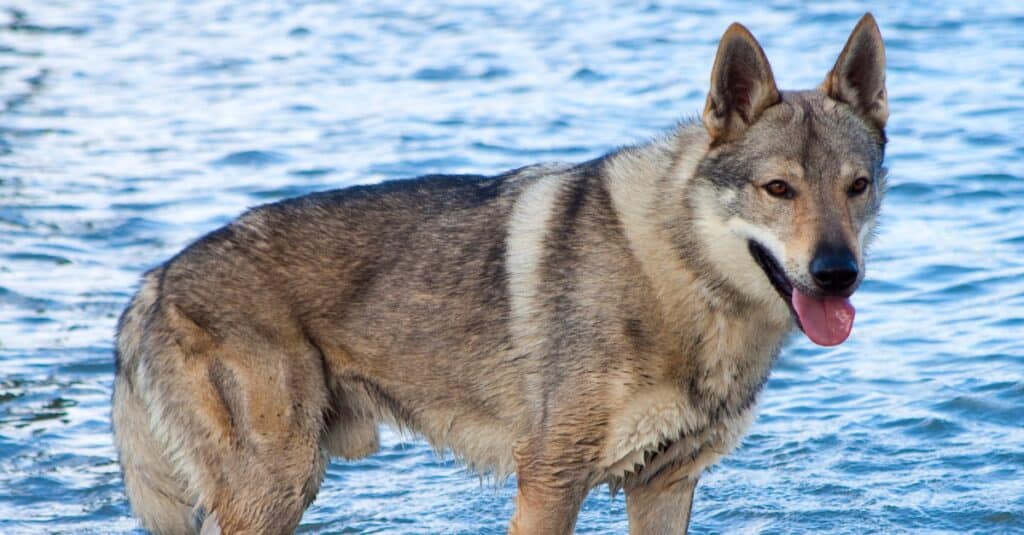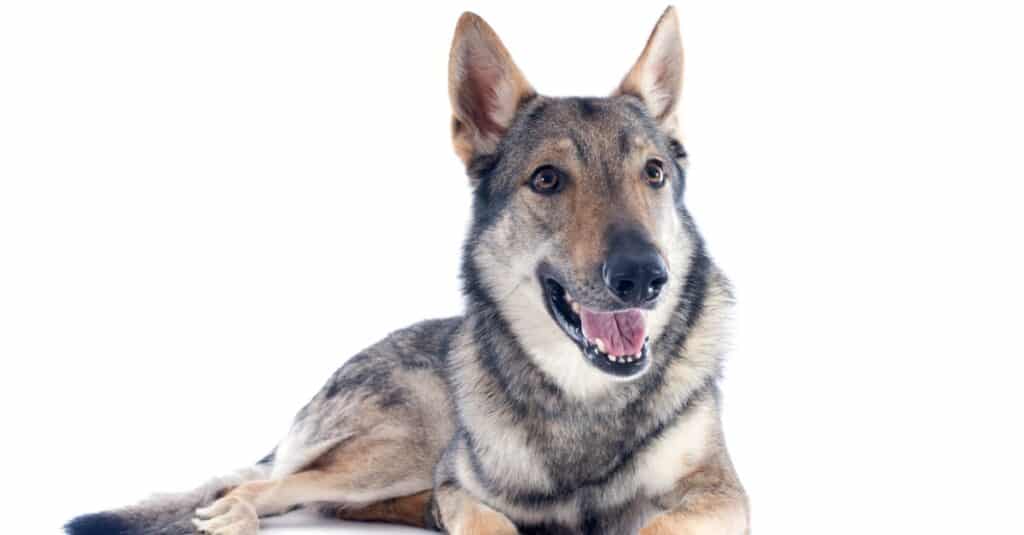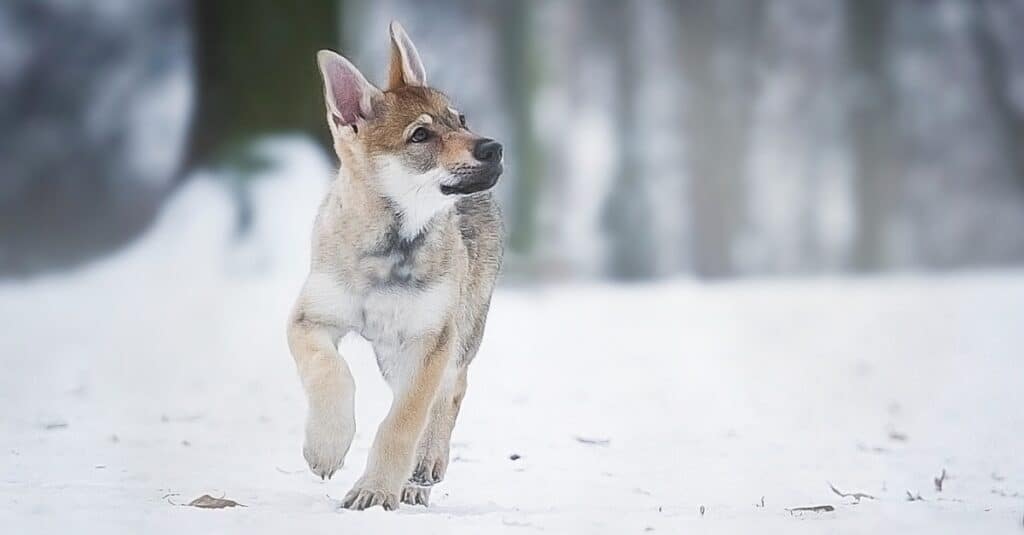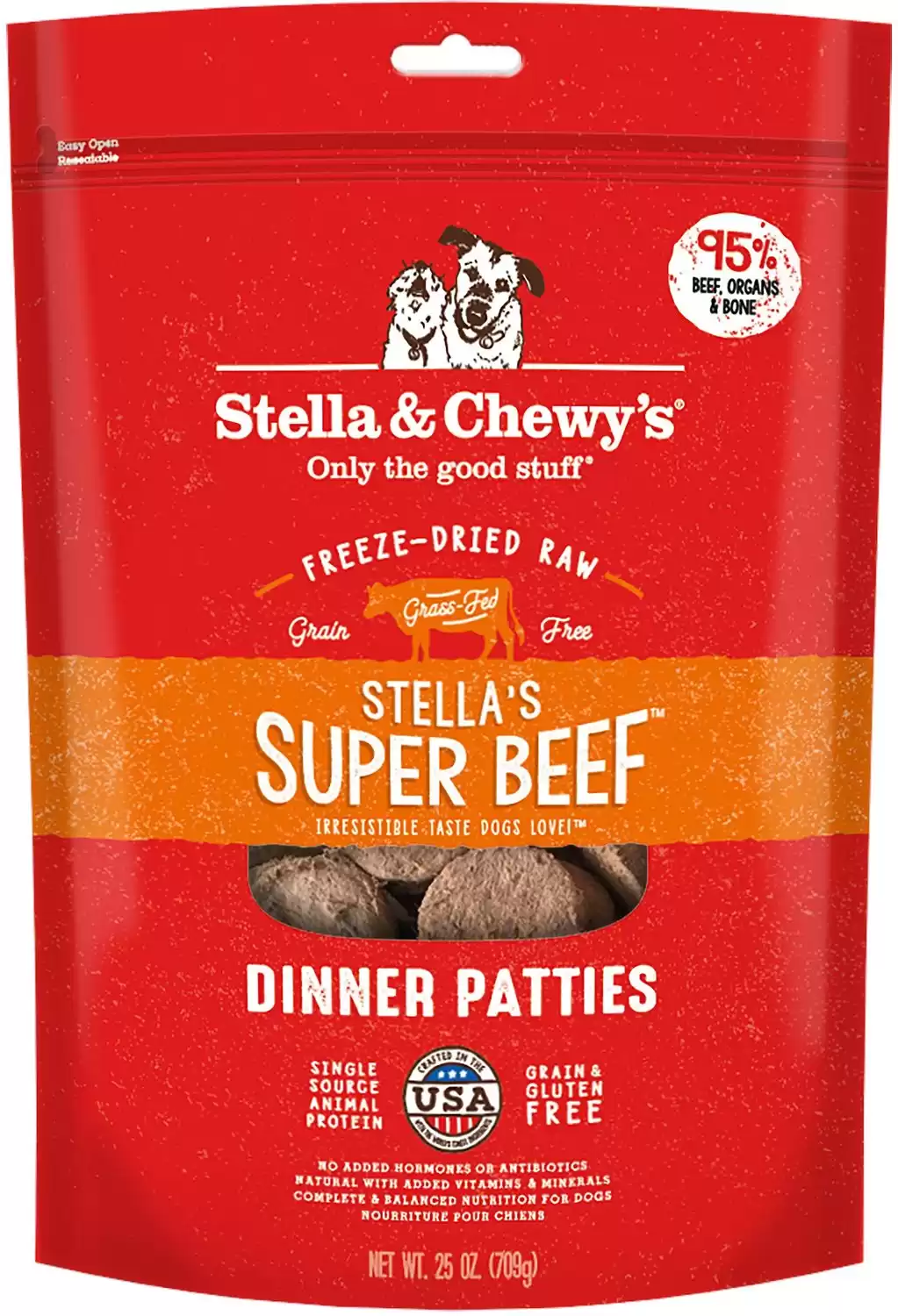Czechoslovakian Wolfdog
Canis lupus
This breed is also known as the Czechoslovakian Vlcak (the name for the German Shepherd).
Advertisement
Czechoslovakian Wolfdog Scientific Classification
- Kingdom
- Animalia
- Phylum
- Chordata
- Class
- Mammalia
- Order
- Carnivora
- Family
- Canidae
- Genus
- Canis
- Scientific Name
- Canis lupus
Read our Complete Guide to Classification of Animals.
Czechoslovakian Wolfdog Conservation Status
Czechoslovakian Wolfdog Facts
- Name Of Young
- puppy
- Fun Fact
- This breed is also known as the Czechoslovakian Vlcak (the name for the German Shepherd).
- Most Distinctive Feature
- upright, triangle ears
- Temperament
- Intelligent, athletic, and loyal
Czechoslovakian Wolfdog as a Pet:
- General Health
- Energy Level
- Shedability
- Trainability
- Intelligence
- Tendency to Chew
- Size
- Family and kid friendliness
- Yappiness / Barking
- Moderate
- Separation Anxiety
- Moderate
- Preferred Temperature
- Average climate
- Exercise Needs
- High
- Friendly With Other Dogs
- Poor
- Pure bred cost to own
- $1,000+
- Dog group
- Working
- Male weight
- - lbs
- Female weight
- - lbs
This post may contain affiliate links to our partners like Chewy, Amazon, and others. Purchasing through these helps us further the A-Z Animals mission to educate about the world's species.
View all of the Czechoslovakian Wolfdog images!

Many people may not realize that dogs and wolves are actually part of the same species. While the dog is technically its own separate subspecies (Canis lupis familiaris), they are both capable of breeding with each to produce viable offspring with few problems. Based on some genetic and archaeological facts, we know that dogs may have been domesticated some 15,000 to 40,000 years ago, diverging rapidly from the rest of the species.
Powerful, loyal, and highly intelligent, the Czechoslovakian Wolfdog is the perfect choice for an owner who wants a big working breed with a bit of a wild side. There are lots of interesting facts about this breed. It was first created from a 1955 experiment to cross a German Shepherd with a Carpathian gray wolf, although the dog makes up the bulk of its ancestry.
See all of our expert product reviews.
The intention was to create a superior border patrol dog with some of the bold and fearless demeanor of a wolf. However, this versatile breed also excels at search and rescue, tracking, herding, and drafting duties. It proved popular enough to be recognized as a national breed in 1982. Although Czechoslovakia no longer exists (it dissolved into Slovakia and the Czech Republic in 1993), the name of this breed stuck.
Today the Czechoslovakian Wolfdog is formally a part of the American Kennel Club’s Foundation Stock Service, which provides support for prospective breeds seeking full recognition. The breed standards mandate a very strong wolf-like appearance with a powerful body, big muzzle, and erect ears. The short but dense coat only comes in gray, silver-gray, or yellow-gray colors with a light mask.

Czechoslovakian wolfdog basking in the sun
©Chawranphoto/Shutterstock.com
Evolution and Origins
The Czechoslovakian wolfdog breed came about as a result of an experiment carried out between 1955 to 1965 in the Czechoslovak Socialist Republic.
Health and Entertainment for your Czechoslovakian Wolfdog
See all of our expert product reviews.
Karel Hartl, the man behind the project, aimed to create a breed of dog that could be used by the border guard by crossbreeding German shepherds and Carpathian wolves. Through careful planning, Hartl was able to breed these two species and create the Czechoslovakian wolfdog breed.
The Czechoslovakian Vlcak is a type of dog that is considered to be primitive in nature and possesses a strong and independent personality which requires a different approach when it comes to training. To train this breed of dog, it is essential to be consistent and patient.
The CSV is known to be self-assured, lively, and active, with a high level of stamina and energy. They are also considered to be strong and obedient with quick reactions.
3 pros and cons of owning a Czechoslovakian Wolfdog
| Pros! | Cons! |
|---|---|
| Intelligent and Hard-working: This breed is an excellent working dog. | Independent-minded: The Czechoslovakian Wolfdog can be a bit stubborn and willful. |
| Protective and Loyal: The Czechoslovakian Wolfdog is a very good watchdog and guardian. | Heavy Shedder: Owners should expect to spend a lot of time cleaning up their fur, especially in the shedding season. |
| Energetic and Athletic: This breed excels at athletic endeavors. | May Not Get Along Well with Children and Pets: This breed may not tolerate other housemates besides adults. |

©magdanphoto/Shutterstock.com
Size and Weight
The Czechoslovakian Wolfdog is highly unusual in that there is no upper limit for its size. However, when making a direct size comparison, males are quite a bit larger than females.
| Weight (Male): | at least 57 pounds |
| Weight (Female): | at least 66 pounds |
| Height (Male): | at least 26 inches |
| Height (Male): | at least 24 inches |
Common Health Issues

Czechoslovakian Wolfdog and Chuskies are quite similar.
©Best dog photo/Shutterstock.com
The Czechoslovakian Wolfdog is a fairly healthy breed with a typical lifespan of 10 to 15 years, but it may be prone to hip and elbow problems, dental problems, eye conditions, and degenerative myelopathy (a nerve-related condition that affects the functioning of the spinal cord and limbs).
It should receive a thorough health evaluation focusing on these particular issues. Other optional tests may include a pituitary dwarfism test, an autoimmune thyroiditis test, and a full cardiac evaluation.
Good breeders should perform many of these tests themselves. You may want to ask them to provide the results of these tests before purchase. You should also maintain regular appointments at the vet to catch health problems as early as possible. In summation, these are the most common health problems with the Czechoslovakian Wolfdog:
- Eye conditions
- Heart problems
- Dental problems
- Cancer
- Hip and elbow dysplasia
Temperament

Because wolf dogs have wolf genes, they automatically have a reputation to be mean.
©Marek Rybar/Shutterstock.com
The Czechoslovakian Wolfdog has the enthusiastic personality of a typical working breed. It is intelligent, alert, protective, hard-working, energetic, confident, fearless, and very loyal to its owner.
It is slightly more reserved than affectionate and sometimes treats its owner more like a pack leader than a member of the family. That doesn’t mean it’s incapable of showing affection; far from it.
This breed is quite friendly and devoted. But it definitely thrives best when it has a job to do. As long as you keep it occupied with plenty of games, activities, exercise, and companionship, this breed will be on good behavior.
How to Take Care of the Czechoslovakian Wolfdog
As an energetic and independent breed with an intense demeanor, the Czechoslovakian Wolfdog is not a good choice for novice or first-time owners. It needs someone with plenty of experience with big, wolf-like working dogs and who understands all the facts behind its care. This breed also needs plenty of physical space and does poorly in apartments. Owners should be prepared to spend a lot of time taking care of this breed.
The Best Dog Food for Czechoslovakian Wolfdog

isolated Czechoslovakian wolfdog
©iStock.com/cynoclub
The Czechoslovakian Wolfdog should do very well on a diet consisting purely of raw food, but grain-free kibble with raw supplements is an acceptable alternative. It will probably need at least three cups of food per day; the exact amount will, of course, depends on the size and activity level of your dog.
Additionally, there are dog foods to help manage to shed, and legume-free dog foods that avoid certain ingredients linked to dog heart failure. Talk to your vet about the best options for your Czechoslovakian Wolfdog.
The opinion of A-Z Animals is that the best dog food for Czechoslovakian Wolfdogs is Stella & Chewy’s Freeze-Dried Raw Dinner Patties.
This raw food’s meaty taste and high protein composition are the heart of this wolf-derived breed’s instincts. This dog food is great for Czechoslovakian Wolfdogs’ actual hearts too, because it cuts out peas and other legumes that pose a heart failure risk.
And the added taurine supports a strong heart too, as well as laser-sharp eyes. The calcium is good for their dental well-being and bones, with glucosamine and chondroitin to help combat hip and elbow dysplasia.
You can buy Stella and Chewy’s Freeze-Dried Raw Dinner Patties for your Czechoslovakian Wolfdog on Chewy and Amazon.
- Freeze-dried beef raw dinner patties
- Supports healthy digestion, teeth & gums, coat and skin
- Grain and gluten free
Maintenance and Grooming
The Czechoslovakian Wolfdog will shed twice a year during the spring and fall seasons. It will need to be brushed almost daily during this time and less often during the rest of the year. Because of the coat’s clean, weatherproof quality, it will rarely if ever need a bath.
However, the fast-growing nails will need to be trimmed regularly with a clipper or grinder to prevent them from cracking or splitting. The ears will need to be checked and cleaned regularly for infections and obstructions. The teeth will need to be brushed quite often as well, preferably with a plan established by your vet.
Training
The Czechoslovakian Wolfdog is intelligent and trainable, eager to learn and perform tasks, but don’t expect the training process to be easy. This breed has a few challenging quirks and nuances that could make training difficult. First, you will need to earn the dog’s respect by establishing yourself as the strong pack leader. Second, this breed will grow bored very easily if you stick to repetitive tasks.
The most important thing is to be patient and consistent with your commands, but try to keep the dog engaged with interesting new activities. Positive reinforcement methods are also recommended but don’t let the dog get away with bad behavior.
Exercise
The Czechoslovakian Wolfdog will probably need at least an hour of exercise daily. They enjoy interacting with their owner through long walks, runs, swimming, hiking, and retrieving balls or flying discs. Because of its strong prey drive, it might not be a good idea to let it off the leash except in a yard with a very big fence.
Puppies
A Czechoslovakian Wolfdog puppy should be trained and socialized early and often to prevent aggressive behavior and an unsociable temperament later in life. Classes can provide a system of support while also acclimating your puppy to the presence of other people and pets.
Crate training can also provide a useful tool for housebreaking and behavioral issues. While a crate should not be used as a punishment (this breed would hardly tolerate being caged anyway), it can provide a safe space for your dog to relax when it’s feeling anxious or stressed.
For any questions about vaccines, spaying/neutering, and micro-chipping, you should talk with your vet.

©Best dog photo/Shutterstock.com
The Czechoslovakian Wolfdog and Children
The Czechoslovakian Wolfdog is not a good choice for homes with younger children. While very loyal and protective, their large size and pack mentality may mean that they tend to only show respect and deference toward adults.
Dogs Similar to the Czechoslovakian Wolfdog
- Saarloos Wolfdog: This large, powerful breed was created from a cross between a German Shepherd and a Siberian gray wolf. It is considered to be perhaps the most wolf-like of all the dog breeds. Some European clubs recognize it, but the AKC does not.
- Shikoku: Also sometimes known as the Japanese Wolfdog (though it doesn’t contain any recent wolf ancestry), this is a medium-sized hunting dog with a highly alert and enthusiastic demeanor and excellent tracking ability. With its dense double coat of black, tan, or red colors, strong pointed muzzle, and curled tail, it is considered to be part of the Spitz family.
- German Shepherd: Beloved by families and prized as a working dog all over the world, the German Shepherd has a rather large, wolf-like appearance, but it actually originated relatively recently, in the 19th century, from European herding and sheepdogs. Most dogs come in tan and black colors with markings around the face and body. The size comparison is fairly similar to the Czechoslovakian Wolfdog.
Famous Czechoslovakian Wolfdog Dogs
There are unfortunately few examples of famous Czechoslovakian Wolfdogs, but they are sometimes used as stand-ins for actual wolves in TV shows and movies.
Popular Names for the Czechoslovakian Wolfdog
If you’re still struggling to come up with a suitable name for your Czechoslovakian Wolfdog, then you might want to consider one of the following suggestions:
- Viktor
- Lobo
- Lupe
- Sylva
- Nina
- Ivan
- Simon
- Duke
- Zeus
- Roxie
Czechoslovakian Wolfdog FAQs (Frequently Asked Questions)
How much wolf is in a Czechoslovakian Wolfdog?
Many people may think this is a wolf hybrid, but actually, due to lots of careful breeding, the Czechoslovakian Wolfdog doesn’t contain that much wolf ancestry at all. Based on genetic analysis, it’s been estimated that anywhere between 6 to 12% is actually a pure wolf. While this breed does superficially resemble a wolf in appearance, it’s much more docile and smaller in its size in comparison to wild members of this species.
Are Czechoslovakian Wolfdogs good pets?
The Czechoslovakian Wolfdog is not your typical canine companion. It’s only recommended if you’re a big fan of this type of dog or you need some kind of working breed to help you. Since this breed is definitely not for everyone, you should be absolutely certain you are able to make the necessary investment to keep this dog happy and content. This is not a dog you can give up for adoption easily if you are struggling to get along with it.
Are Czechoslovakian Wolfdogs legal?
Wolf-dog hybrids are illegal to purchase or own in some places, but the Czechoslovakian Wolfdog is usually considered to be a normal dog breed, not a wolf-dog hybrid, as it’s registered with several different kennel clubs. You might want to check the local laws of your state or country just to make sure, but there should be few barriers to ownership.
How do I pronounce Czechoslovakian Wolfdog?
The name is usually pronounced as Check-oh-slow-vah-kee-an or something similar. This is a combination of the terms Czech and Slovakian, two somewhat distinct entities that formed a single country in the aftermath of World War I. The country broke apart in 1993 after the collapse of the Communist government.
How healthy is a Czechoslovakian Wolfdog?
The Czechoslovakian Wolfdog is a healthy breed with an excellent lifespan, but it might be prone to several common canine conditions, including teeth problems, heart disease, and eye disorders.
What is the price of a Czechoslovakian Wolfdog?
The price of a new puppy from a trustworthy breeder will probably be at least $1,000, depending on several factors such as its pedigree and heritage. If you are unable to afford this price, then you might want to try adoption as an alternative. A list of trusted breeders and rescue organizations might be found by checking with the American Kennel Club, the Czechoslovakian Vlcak Club of America, and other clubs with which this breed is registered.
Thank you for reading! Have some feedback for us? Contact the AZ Animals editorial team.
Sources
- American Kennel Club, Available here: https://www.akc.org/dog-breeds/czechoslovakian-vlcak/


















